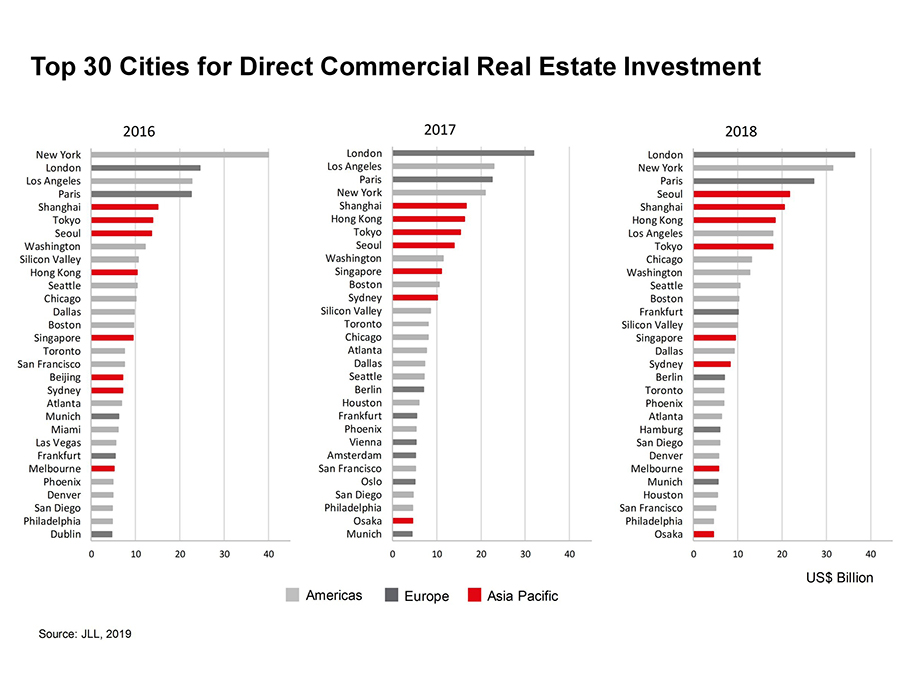London Draws Most Global Real Estate Investment
Despite Brexit concerns, the city topped JLL’s list for the second consecutive year, with Los Angeles, Paris and Shanghai also among the most coveted markets. But which gateway destination is the runner-up?
Gateway cities remain heavily important in large, global commercial real estate, according JLL’s most recent research.
“In a year when investors have had to deal with increasing populism, protectionism and political uncertainty, the appeal of real estate as an asset class has continued to increase, up 4 percent in 2018 on the already buoyant levels of 2017 and the highest level for a decade,” Jeremy Kelly, JLL’s research director, told Commercial Property Executive. “Despite the increasing number of potential investment destinations on the international radar, investors continue to focus on a relatively small number of the large and liquid gateway cities.”
In the report, 30 cities accounted for half of all global real estate investment, with London topping the list for the second year in a row.
 “Despite Brexit concerns, London has remained the top destination for real estate capital,” Kelly said. “Volumes have been boosted by high levels of foreign investment, with almost half of all purchasers in 2018 involving a foreign buyer. Investors perceive that this may be a ‘once-in-a-lifetime’ opportunity to buy into a large liquid and transparent market on favorable terms.”
“Despite Brexit concerns, London has remained the top destination for real estate capital,” Kelly said. “Volumes have been boosted by high levels of foreign investment, with almost half of all purchasers in 2018 involving a foreign buyer. Investors perceive that this may be a ‘once-in-a-lifetime’ opportunity to buy into a large liquid and transparent market on favorable terms.”
After falling to fourth in 2017, New York jumped back to second place as volumes picked up from the cyclical low-point seen that year. The rebound in the city has been driven mostly by domestic groups, who provided 72 percent of all liquidity in the market in 2018, as offshore capital flows remain 38 percent below the average annual volume seen since 2014.
The research revealed there was a total volume of $733 billion in 2018, an increase of 4 percent from the previous year. That number was also the highest in 10 years.
Consistency in investments
The data further showed that investors are favoring markets they are already familiar with and already offer high levels of transparency. A dozen cities—London, New York, Paris, Seoul, Hong Kong, Tokyo, Shanghai, Washington D.C., Sydney, Singapore, Toronto and Munich have all ranked in the top 30 each year since 2008.
One surprise from the research, Kelly said, was that Asian cities are beginning to dominate the top ranks.
“Not only Tokyo, Hong Kong and Singapore, which have traditionally been among the top group, but also Shanghai and Seoul,” he said. “As the level of transparency increases, we should see more investors moving into Asian markets.”
This year, JLL foresees investment volumes to decrease nearly 5 to 10 percent below the 2018 total, a result of expected investor selectivity and caution.
“The current economic cycle is one of the longest in history and this is being reflected in the property cycle,” Kelly said. “Yields are now at (or very close to) their anticipated cyclical lows in most markets across the globe. However, a sharp correction is unlikely as there is still a significant weight of capital looking for real estate assets and corporate occupier market fundamentals across many markets are positive. This creates the potential for continued strong income growth.”
Additionally, the research noted that the institutional real estate universe will continue to expand, driven by factors such as lower volatility, diversification benefits, long-term income and an attractive pricing premium to core sectors. Therefore, asset classes such as student housing, senior living and multifamily, which attracted more institutional money in 2018, will likely see similar results in 2019.
In 2018, JLL released the 25-page World Cities: Mapping the Pathways to Success, which encourages the global real estate market to rethink how it evaluates the world’s cities’ strengths and opportunities for investors, developers and corporate occupiers.
Images courtesy of JLL








You must be logged in to post a comment.